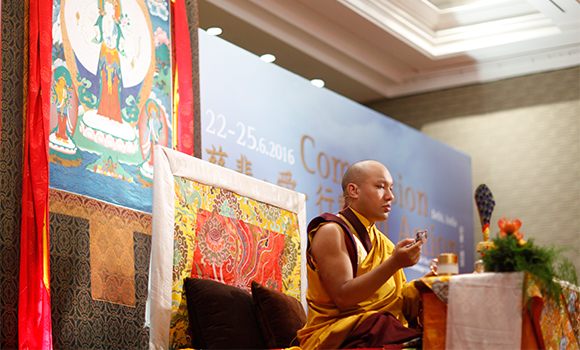
June 25, 2016 – Delhi, India.
The focal point of the spacious hall has become the tall, radiant thangka of a brilliant white Avalokitsehvara with 1000 arms and 1000 eyes. Right beneath it is the Karmapa’s throne and to stage right, wood screens have been placed in front of the altar where the Karmapa would perform his preparations for this empowerment. In the middle of a procession, he entered the hall from the back door, walking down the long main aisle as monks led the way with incense. While disciples chanted Om Mani Padme Hung and Karma Khyenno, the sound of Karmapa’s bell rang through their voices from behind the screens.
After he finished and took his seat on the throne, a mandala was offered. Soon the Karmapa paused during the ceremony to explain the vows to come. There are two ways to go for refuge, he said. Taking refuge alone is to foster our faith, but when we speak of the vow of refuge, that involves a commitment to be kept and precepts to follow, so we have to prepare ourselves for it. The way we go for refuge is to think of the Buddha as the teacher, the Dharma as the path, and the Sangha as our companions along this path. His Holiness then gave the refuge vow and read from his text, explaining that refuge and bodhicitta are given before an empowerment to purify our mindstreams.
He continued, “There are three initiations to bless our body, speech, and mind. The initiation of the body facilitates visualizing the deity; that of speech, the recitation of the six-syllable mantra and the longer dharani; and that of the mind, receiving into our minds the blessings of the emblems of Avalokiteshvara, such as the white lotus.”
After the Karmapa had bestowed this initiation, the offerings of thanksgiving were made by most everyone present. He remarked that in order for people’s minds to feel comfortable and satisfied, he would personally give the blessing of the empowerment to everyone, so he descended from the throne, and ringing the bell with his left hand, he blessed everyone with an image of Avalokiteshvara in his right—one that had been on the shrine from the time of the preparation. While the Karmapa passed along the long rows, the sound of his bell locating him in space, everyone chanted the six-syllable mantra of Avalokiteshvara.
Once back on the throne, His Holiness finished the empowerment and gave three reading transmissions. Then the time of offerings from everyone began, first to the Karmapa and, once he had walked back down the central aisle and left the hall, everyone stood in a long line to make offerings to the ordained Sangha of monks and nuns, drawing the ceremony to a close with their kindness and generosity.


